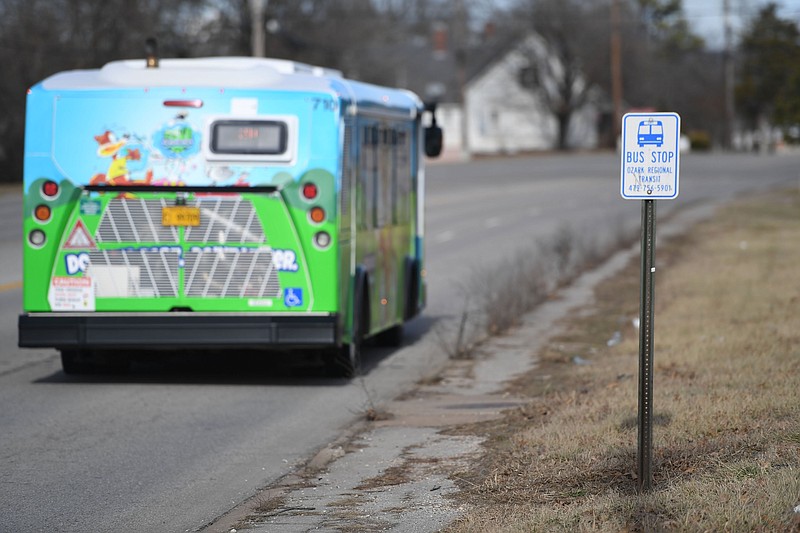Regional planners and transit providers are hoping to get more than half a million dollars in federal grant money to help upgrade bus stops in areas of Fayetteville, Springdale and Rogers that are deemed to be "areas of persistent poverty" based on census data.
Bentonville did not have any areas of persistent poverty.
Olsson Engineering did a study of Ozark Regional Transit's 414 bus stops last year that found the vast majority need to be upgraded. Ozark Regional Transit officials say they don't have the needed money.
They've asked cities to help with sharing the costs, but they're also working with the Northwest Arkansas Regional Planning Commission to go after an Areas of Persistent Poverty grant that would pay for engineering and design services to upgrade the bus stops in those designated areas.
There are 341 stops located in tracts that are either Areas of Persistent Poverty or Historically Disadvantaged Communities, and therefore eligible for the grant. That's 59% of the stops in the region, according to Shawn Strate with Olsson, the engineering firm writing the grant application. Those numbers include stops inside on-demand transit zones with no fixed-route service.
Areas of Persistent Poverty are defined as a county or census tract with at least 20% of residents living in poverty, based on various historical census data over the last 30 years. About $20 million is available through competitive grants to eligible applicants for planning, engineering or development of technical or financing plans for projects in these communities.
If successful, the region could then apply for additional grants to help cover construction costs, officials said.
"This is one of the most exciting things I think that we have done here at Ozark Regional Transit since I've been here," said Joel Gardner, executive director. "I don't recall where we were doing something for transit as a whole in Northwest Arkansas and this is really, really cool to me. This is a grant that is going to include Ozark Regional Transit, Razorback Transit, spearheaded by Regional Planning Commission, which is our designated recipient, and it's going to affect the whole service area one way or another."
Regional planners gave their blessing to apply for a $540,000 Federal Transit Administration grant Wednesday. A 10% local match of $60,000 would be required, which would be split between Ozark Regional Transit and Razorback Transit.
The three cities are also being asked to jump on board and support the grant request, as are the University of Arkansas and the state's congressional delegation.
Most stops are no more than a patch of bare ground and a sign, according to the Olsson study. Passenger amenities are limited, problems persist with accessibility for disabled people and other riders and few shelters exist for those waiting on buses.
Upgrading stops to a basic level of accessibility should be a primary goal, according to the study. The vast majority of stops don't comply with the Americans with Disabilities Act. While most stops do have a sidewalk nearby, only 14% have a concrete landing pad connected to the sidewalk.
For disabilities act compliance, a firm, stable surface -- typically a concrete pad at least 8 feet by 5 feet and aligned with the front door of the bus -- is required.
The landing pads allow wheelchair users to board a bus using a ramp or lift extending from the bus. For those able to walk to and from the stop, a concrete landing pad provides an unobstructed space free of tripping or other hazards and free of mud or other unstable surfaces.
The landing pads, in addition to bus stop signs, add visibility to the stops and make clear where the front door of the bus will be. That helps passengers know where to wait for the bus and helps make them more visible to the driver.
Ozark Regional Transit commissioned the study with a grant from the Walton Family Foundation.
The region's 10-year transit development plan, called Connect Northwest Arkansas, recommends three levels of bus stop improvements. Level 1 stops are to have accessibility for disabled passengers, a bus sign and system information. Level 2 stops add a shelter and bench as well as connections to sidewalks. Level 3 stops add lighting for safety, trash cans, landscaping or planters and art or something to provide a sense of place.
The Olsson study adds a fourth.
Level 4 stops are mobility hubs with all available amenities, according to the study. They're located in areas with high ridership and bus transfers take place there.
Olsson estimates the grant could pay for engineering and design services for about 60 stops to a Level 3 standard.
It would cost more than $3.6 million to bring all stops up to the recommended levels immediately, according to the study.
More News
NoneKey findings
The bus stop survey inventory done by Olsson Engineering last year collected detailed information on each stop in the Ozark Regional Transit system. The data is fully documented in a database for use by the transit system and partner organizations. Here's a quick look at the findings.
In total, 414 stops were reviewed and:
386 (93%) have a bus stop sign.
323 (78%) have a nearby sidewalk.
150 (36%) have a nearby sidewalk of 5 feet or greater.
36 (9%) have a bench. An additional four stops have some other type of seating nearby.
23 (6%) have a trash receptacle.
22 (5%) have a shelter.
55 (14%) have a concrete landing area of at least 5 feet by 8 feet and are connected to a sidewalk. (Due to other factors not surveyed, these stops may not be fully compliant with the Americans with Disabilities Act.)
Source: Olsson Engineering
